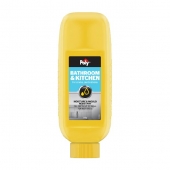How to
Here you'll find a selection of helpful how-to guides and videos to help you achieve that perfect finish for your next project. To continue, please specify the area of the house you are working on from the interactive map below.
How to seal joints & gaps in damp areas
Getting a proper seal around joints and gaps in baths, basins, shower recesses and sinks prevents water penetration. Leaks are often due to old silicone that needs replacing but and can cause damage to your home down the track. Using a specially developed silicone sealant for damp areas such as Poly Kitchen & Bathroom will ensure a watertight seal as well as resistance to mould and fungus growth.
You'll need:
- Poly Kitchen & Bathroom Silicone Sealant
- A caulking gun
- Sharp knife
- Spatula
- Mineral turps
- Ensure surfaces are clean, dry and free of oil, dust, grease, flaking paint and old silicone. To remove old silicone, use a sharp knife and then scrape away residual silicone. Clean and dry the surface with mineral turpentine. To ensure a neat finish, tape both sides of the gap before applying the sealant.
- Cut the tip off the cartridge and then cut the nozzle at a 45 degree angle to give the desired bead thickness. Place the cartridge in the caulking gun and fit the nozzle.
- Hold the gun at a 45 degree angle and dispense the sealant ensuring that it is pushed right into the joint.
- Smooth off the sealant with a spatula dipped in detergent. Remove excess sealant immediately with a cloth dampened with mineral turpentine. Remove the tape before the sealant skins.
- The silicone will skin in 5-10 minutes and will be fully cured in 24 hours.
Tip
If you haven't used your whole cartridge, you can re-seal it for another job by popping a small pencil or wooden rod in the end and putting tape over it.
Safety
Avoid breathing vapours and contact with skin and eyes.

